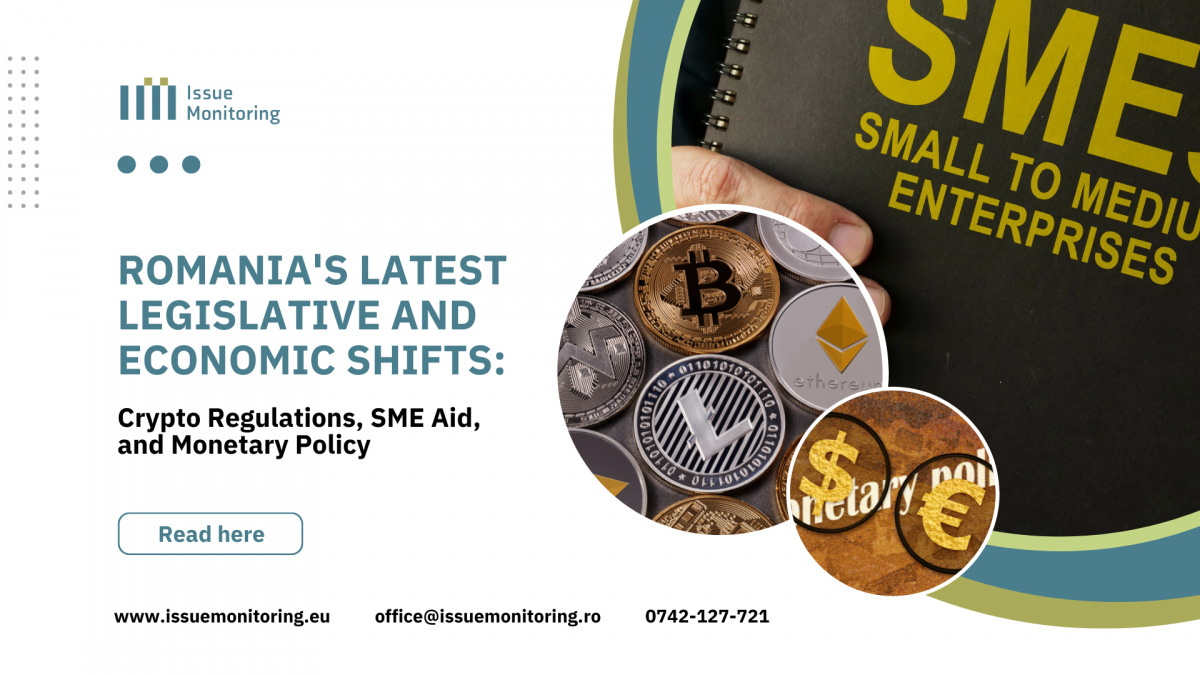
Article written by Cezar Petrescu, Senior Public Policy Specialist @Issue Monitoring
Romania has recently witnessed several significant legislative and economic changes that impact various sectors, from cryptocurrency service providers to small and medium-sized enterprises (SMEs). These developments align with the country’s ongoing efforts to modernize its financial regulations and adapt to the evolving European Union (EU) framework.
New Crypto Regulations: Transposing Directive (EU) 2015/849
One of the most notable updates is the transposition of Directive (EU) 2015/849, which targets the prevention of financial systems being misused for money laundering and terrorist financing. A draft emergency ordinance, introduced for public debate, aims to classify crypto-asset service providers as financial institutions. This classification will impose stringent obligations on these entities, particularly regarding cross-border transactions and the identification of risks associated with transfers involving unknown crypto-asset addresses.
This shift is part of a broader EU strategy to enhance oversight of digital assets, bringing crypto service providers under the supervision of the National Bank of Romania (NBR). The new legislation extends NBR’s authority to include crypto institutions, adding another layer of scrutiny to a sector that has, until now, largely operated outside traditional financial regulations. The draft law is expected to be adopted in an upcoming government meeting, marking a pivotal moment for the cryptocurrency industry in Romania.
Updates on Bank Recovery: Transposing Directive (EU) 2024/1174
In addition to crypto-related regulations, Romania is also moving forward with the transposition of Directive (EU) 2024/1174, which brings amendments to existing EU banking regulations, specifically the Bank Recovery and Resolution Directive (BRRD) and the Single Resolution Mechanism Regulation (SRM Regulation). This new directive focuses on internal MREL (minimum requirement for own funds and eligible liabilities) within bank resolution groups.
The changes address the complexities of bank recovery mechanisms, a topic of growing importance amid global financial uncertainties. With an impending deadline of November 2024 for implementation, Romanian authorities are poised to bring their banking laws in line with EU requirements, ensuring a more robust framework for financial stability.
SME Aid Schemes: New Orders for Business Growth
Supporting the growth of small and medium-sized enterprises remains a priority for Romania’s economic policy. Three new orders issued by the Ministry of Economy introduce updates to the minimis aid schemes for several SME-targeted programmes. These include:
The Programme for the Development of Market Activities
The Programme for Accelerating SME Growth
The Multiannual National Micro-industrialization Programme
These amendments, now in effect following their publication in the Official Gazette, aim to streamline implementation processes and enhance the accessibility of these programmes for Romanian entrepreneurs. By offering targeted financial aid, the government hopes to boost the competitiveness of local businesses and stimulate broader economic growth.
Economic Outlook: Monetary Policy and Inflation Trends
The economic landscape in Romania has also seen shifts in monetary policy and inflation trends. The National Bank of Romania recently reduced the monetary policy interest rate to 6.5%, following a previous cut. This move, mirrored by reductions in both the lending (7.5%) and deposit facilities (5.5%), comes in response to the NBR’s optimistic inflation forecasts.
Minister of Economy, Ştefan Radu Oprea, expressed optimism about the reduction, emphasizing that it will lead to more affordable credit for companies. However, the inflation picture remains complex. According to the National Institute of Statistics (NIS), inflation rose to 5.4% in July 2024, slightly higher than the previous month. Eurostat data further highlighted that Romania had one of the EU’s highest inflation rates in July at 5.8%, surpassing even the NIS figures.
Despite these short-term challenges, the NBR expects inflation to slow down in the coming years, with projections of 4.0% by the end of 2024 and 3.4% by 2025. However, this trajectory is subject to various external factors, including fiscal measures and international price fluctuations.
Conclusion
As Romania adapts to evolving EU directives and implements new national policies, the business environment is set for significant change. From crypto regulations that bring digital assets under tighter scrutiny to financial aid for SMEs and a cautiously optimistic monetary policy outlook, these shifts reflect Romania’s efforts to balance modernization with stability. Business leaders and investors will need to stay informed and agile as these changes unfold in the months ahead.
Follow the Issue Monitoring blog and you will always be up to date with the latest legislative changes affecting your industry.


